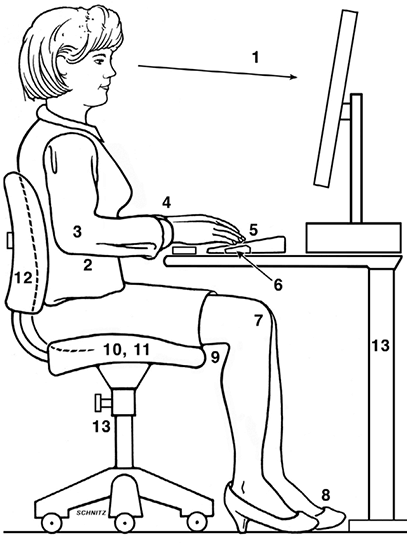Workstation Design for the Best Desk Ergonomics
Proper body positioning at your computer workstation is important for maintaining good physical health. To ensure your workstation provides the best desk ergonomics, there are several different factors you should check.
What to Evaluate

- Monitor screen – eye level and at arm’s length away
- Elbows – rest next to the body
- Elbows – bent at 90 degrees
- Wrists – neutral (straight) position
- Table / Keyboard – allows elbows to bend 90 degrees
- Mouse – mouse is placed beside the keyboard
- Knees – level or slightly lower than hips
- Feet – rest on the floor or on a footrest
- Chair seat – soft edge by knees
- Chair seat – approximately 18 inches wide
- Chair seat – approximately 15 to 17 inches deep
- Chair back – low and middle back support
- Chair height – adjustable, allowing feet to rest flat on the floor
Workstation Design Consulting
The Indiana Hand to Shoulder Center has been studying and evaluating proper computer workstation design and best desk ergonomics for many years.
We’ve found that significant problems can arise from improper body positioning, improper equipment, long periods of time working on the computer without breaks and poor body conditioning. Some common problems include tendonitis and carpal tunnel syndrome.
Our occupational therapists have presented numerous medical education seminars/workshops to healthcare professionals, employers and their management staff/employees on these topics, along with therapy approaches for minimizing the risk of upper extremity medical conditions.
We offer the following programs to help minimize the likelihood of developing a costly upper extremity medical problem. These programs are available to: employers, plant physicians, case managers, occupational medicine physicians, family practitioners and internists for their staff and patients:
- Computer workstation design evaluation and assessment (on-site)
- Computer workstation modification program
- Ergonomic Educational Services
- Home flexibility exercise and education programs
No part of this work may be reproduced without written permission from the Indiana Hand to Shoulder Center.
If you have questions regarding your computer workstation, please contact the Indiana Hand to Shoulder Center at 1-800-888-HAND (4263).
Disclaimer: The materials on this website have been prepared for informational purposes only and do not constitute advice. You should not act or rely upon any medical information on this website without a physician’s advice. The information contained within this website is not intended to serve as a substitution for a thorough examination from a qualified healthcare provider. The display of this information is not intended to create a health care provider-patient relationship between the Indiana Hand to Shoulder Center and you.
Workstation Design Patient Handout
